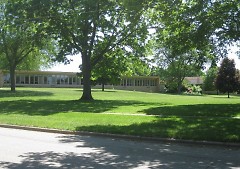Vista Springs, LLC opened Riverside Elementary up to the public on June 5 and 6 so they could walk through the school's halls one more time and remember or imagine school bells, the recitation of the Pledge of Allegiance, Halloween costume parades, Christmas programs, spelling tests and those bright June moments when school finally let out and the green grass of that wide lawn felt and smelled like summer and freedom.
I've lived three doors down from Riverside Elementary for 15 years now and have walked past it daily with my dogs. My son played on the playground equipment behind the building, and more than one of my dogs has bolted into the school's shrubs after a rabbit. The elementary school was repurposed into a middle school before my son was old enough to attend, and has been closed entirely for several years. Riverside Elementary is an attractive mid-century building with a long sloping lawn and many mature trees. A few decades ago, my neighbors say, the Riverside Gardens area was filled with families with young children, and they walked to school in the morning and home in the afternoon. They stayed after school to swing on the swings or stopped at a neighbor’s house on the way home to play with a friend. I’ve wished many times that the Grand Rapids Public Schools had not closed Riverside, but, until last Friday, I’d never been inside.
The building itself is still lovely after all these years, with its blonde wood built-ins, wide windows and fine views. Unfortunately, vandals broke in numerous times during the past year and smashed windows and many of the dishes left in the kitchen space off the old gym. The paint in some spots is peeling off the walls and ceilings. But in most ways the building seems like it's just as ready for service as it ever was. Even the utility rooms like the janitor's closet and the furnace and mechanical rooms feel the presence of those older men who knew how to fix anything from a broken cabinet washer to a fussy radiator. The cubbies are still labeled: "polishes," "sponges," and there are small boxes of nails and other bits and pieces left behind to attest to their years of service.
Many of the chalkboards still have teachers' names, daily schedules or multiplication problems written on them. Wooden pegs hang low on the walls ready for tiny coats and hats, and library shelves are still labeled with Dewey numbers. An old Kelvinator stove sits in the corner of one classroom, ready for a home ec student to bake bread or fry up some scrambled eggs. Vista Springs intends to reuse whatever is possible of the building's many attractive architectural elements in its new construction, but it certainly will not look like a school anymore after it is repurposed.
I have a strong nostalgia for mid-century things, even though I was born in the 1970s and played with plastic toys instead of metal or wood ones. By the time I was old enough to remember school, the Pledge of Allegiance was beginning to be controversial, and we had “winter” holidays instead of Christmas ones. Many of my friends’ mothers were not home after school, and some of their fathers lived in different houses or cities. So Friday when I sat in the pooling sunshine on the well crafted built-in blonde wood benches and looked over the tidy classrooms with their lined chalkboards and glass-case entrances, I experienced that longing again for a more orderly, predictable time when parents were comfortable letting their children walk home from school alone, and children might worry that they would get the ruler if they misbehaved but couldn’t comprehend worrying that another student would bring a gun into school and shoot them.
Buildings like Riverside Elementary were built to address the sudden need for schools for the Baby Boomers who were reaching school age 60 years ago. Since our urban neighborhoods and school systems have changed radically, many of them have closed, and they are now being repurposed to care for the same group at a different age. But I wish that era of community and local neighborhood schooling could have lasted a bit longer and my son and I, as well as future generations, could have taken part in it as well.
The Rapidian, a program of the 501(c)3 nonprofit Community Media Center, relies on the community’s support to help cover the cost of training reporters and publishing content.
We need your help.
If each of our readers and content creators who values this community platform help support its creation and maintenance, The Rapidian can continue to educate and facilitate a conversation around issues for years to come.
Please support The Rapidian and make a contribution today.
